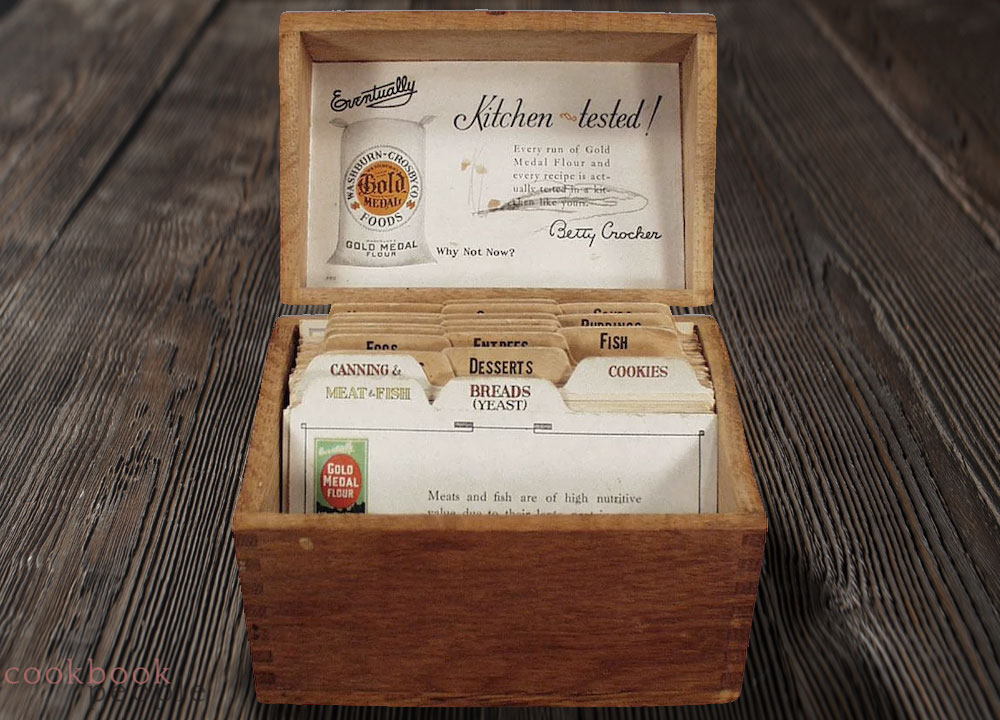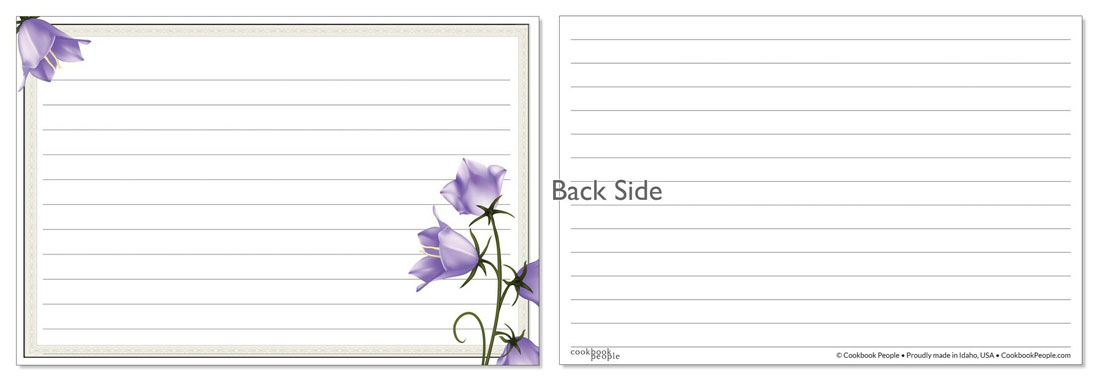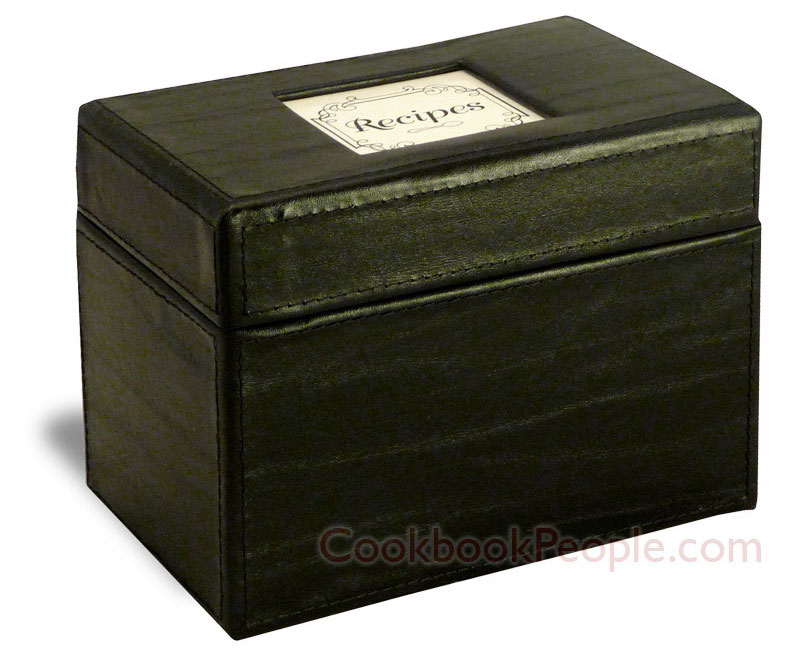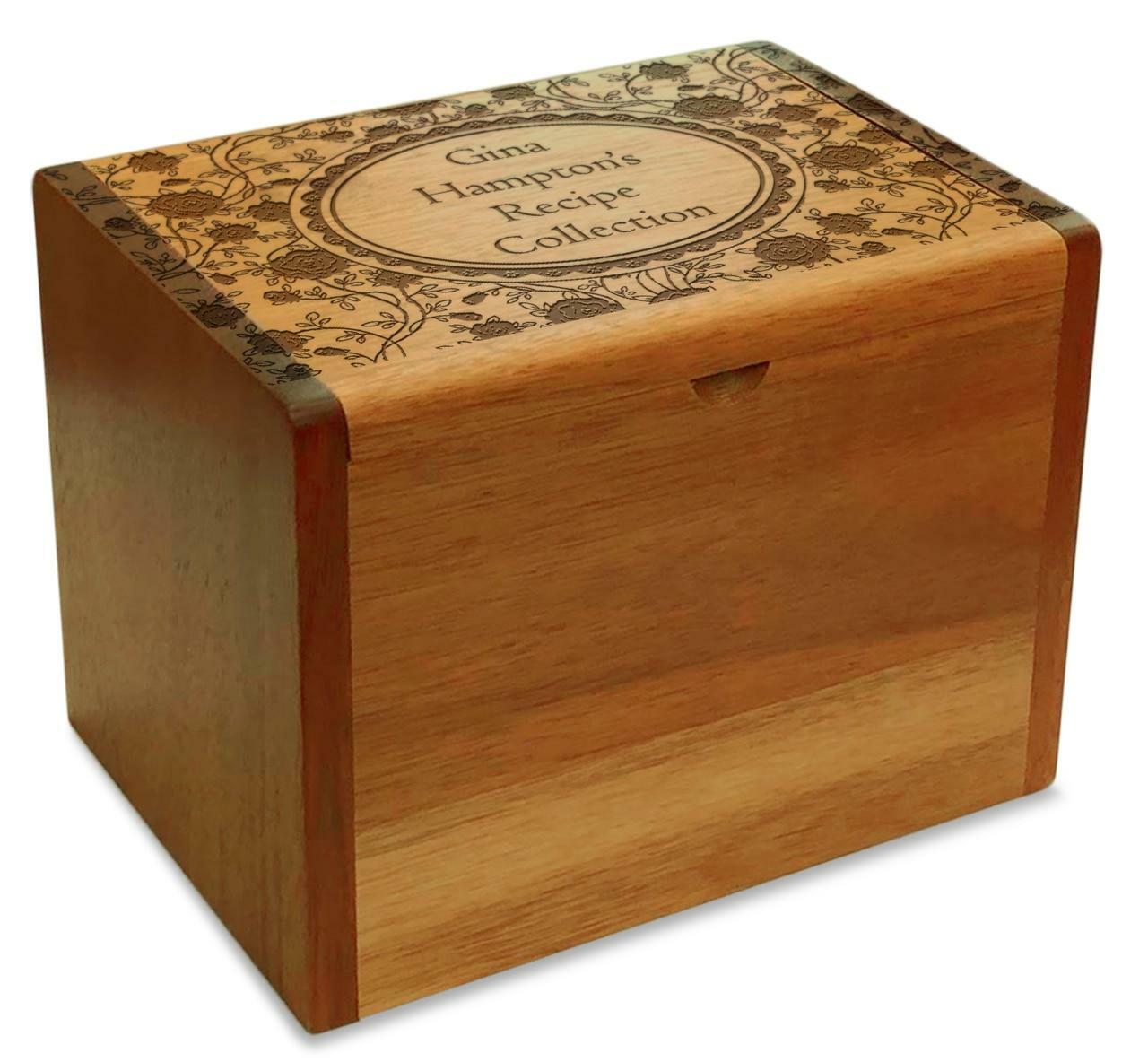Everything there is to know about Recipe Boxes
- Introduction
- The History of Recipe Boxes
- Six Things You Need to Consider When Buying a Recipe Box
- How Many Recipe Cards will Fit in a Recipe Box?
- Materials: Wood Recipe Boxes vs The Rest
- Wedding Recipe Box: Make it Memorable for Everyone
- Make Your Own Recipe Box
- About Recipe Cards
1. Introduction
It’s just as important to know the product as it to know the people on the other side of it. We’re Erin & Ted—the brains behind the box, a.k.a. the founders of Cookbook People. We’ve put this introductory guide together not to try to sell you our stuff—it sells itself! —but because transparency is important to us. The only secrets we keep are your cherished family recipes in any handcrafted and customizable recipe box of your choice.
Not sure where to start? Keep reading to learn more about recipe boxes and all of the product variations we have available to you. Feel free to click on any of the included pictures to get to our store and see more personalization options and accessories. Or just keep reading!
Erin & Ted
Founders
Cookbook People

2. The History of the Recipe Box
Even in this digital age we live in, recipe boxes continue to be a timeless confidant in the kitchen. Sometimes it might seem easier to whip out our phones and hop online for a recipe rather than source them the old-fashioned way. But where recipe boxes have the internet beat is by virtue of the legacies they carry. Google won’t be able to unearth your great-grandmother’s made-from-scratch chocolate sheet cake (no matter how “famous” she claimed it was.) In her recipe box, however, is the right place to look.
The origin of the recipe box begins with the cards within, so let’s start there:
The true emergence of the recipe card really didn’t take place until precise measurements and specific step-by-step directions became commonplace in the kitchen in the 1920s. Prior to this time, most handwritten recipes consisted of very broad instruction and ingredient lists that oftentimes weren’t quantified—in other words, lots of eyeballing. When the 1920s rolled around, the American Dream was, at the time, defined by separate spheres. Women were left in charge of domestic duties (cooking, cleaning, tending to their children, etc.) while their husbands fulfilled the roles of 9-to-5 breadwinners.
With such societal pressure for women of the ’20s to be ideal wives and homemakers, women’s magazines saw a prime marketing window among the housewife demographic, specifically women who perhaps weren’t all that adept in the kitchen thus needed any help they could get. These home lifestyle magazines that already entertained a female-dominant target audience began to advertise subscriptions for perforated recipe cards with the latest and greatest recipes to impress their family and friends with.
From there, people (mostly women) took the recipe card idea and ran with it. Instead of keeping up with subscriptions, everyone started to write their own personalized cards to either keep sacred in their personal collection or share within their social circles. It became both a hobby of trade, but also a means of archiving kitchen skills and secrets. And so, the advent of the recipe box was somewhat inevitable. Recipe card collectors need a designated place to store their personal library, so most initially opted for shoeboxes or household tins/containers. Betty Crocker’s Gold Medal Box was one of the first ever commercially available recipe boxes. In a partnership with Gold Medal Flour, Betty Crocker debuted this wooden recipe box in 1920, which included a card filing system and a complementary recipe subscription by mail, all for only 70 cents.
Until independent vendors began crafting their own wooden boxes made specifically for recipe card storage, people sourced their recipe boxes from repurposed wood boxes or local woodworkers. Wood was the preference and it still is! The hunt for a trusty recipe box is far simpler these days—find the perfect box for either yourself or a loved one here!
3. Six Things You Need to Consider When Buying a Recipe Box
1. Do you really want a recipe box?
A recipe box makes a lot of sense if you mostly have scraps of paper in the dimensions of 4x6 or smaller. But if you have a lot of recipes that are printouts from off the internet or clipped from magazines, you may spend a lot of time re-rewriting them onto recipe cards.
Personally, I like re-writing recipes onto cards. It allows me to modify the recipe to my own personal experience. And I love knowing my kids will inherit something I actually wrote when everything seems to be going digital these days.
However, there's a nice compromise between the narrow confines of a recipe box and the depersonalized system of tracking everything on your phone: The Recipe Binder. A lot of our customers prefer these because they can accomodate all paper sizes, from 4x6 cards up to full-page newspaper clippings (folded in half). Give our recipe binders a look-see first to consider if they make more sense for you.
Here's an overview of our recipe binders with many of the pros and cons:
2. Do you need extra recipe cards?
The answer is, of course, yes! An emphatic yes! Not just because you'll need more recipe cards handy for the exciting new discoveries that come up ever year. But you'll also want to share your favorites as well with people you love. What better way to do that than to hand-write the recipe on a card? With everything going digital, the simple act of writing out a recipe card by hand can make such a personal statement to a close friend or daughter. Make sure to stash a stack of blank recipe cards in the back of your recipe box so you'll always have some extras to give away.
You can find our whole recipe card collection here, but below are our three hottest trending recipe cards right now:
3. Are your recipe cards going to stay clean and safe? Especially the old ones?
Like a fine stew, the older recipe cards get, the more personality they seem to have! Also like a stew, they do get a lot of things tossed on them. You definitely need to get some recipe card protector sleeves to ensure they stand the test of time. Especially if they've got grandma's handwriting on them! Our recipe card sleeves are available here.
4. How are you going to organize your recipe box?
There are four general strategies for organizing your recipe cards within the recipe box:
- By Serving Type: This is the usual standard. Entrée, Salad, Dessert, etc. There are lots of recipe card dividers available like this one that give you the main categories.
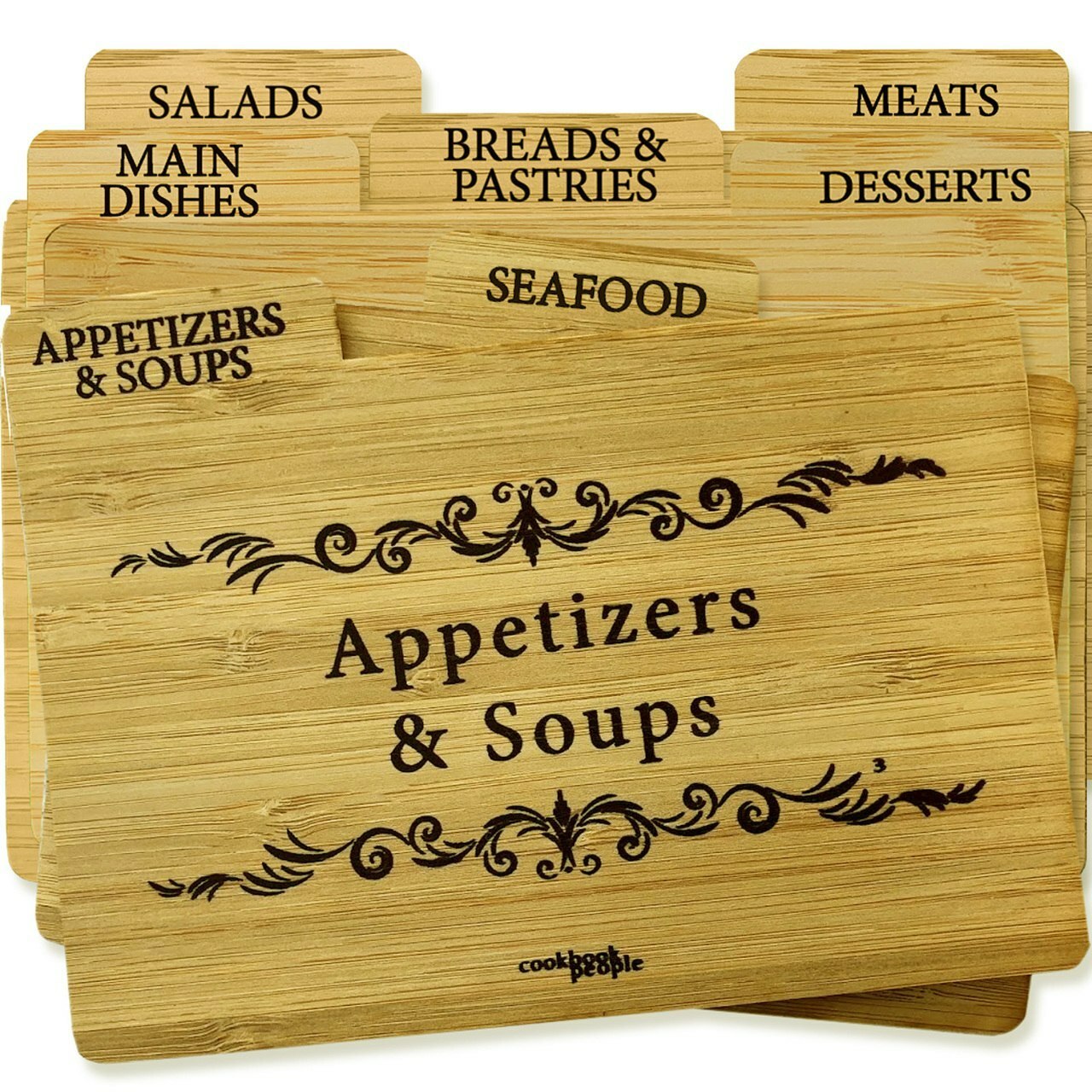
- Alphabetically. Are you some kind of monster?!? Actually, there is a rational way to do this that works really well. Just make sure to do away with all fancy titles. "Aunt Gertie's Tuscan Ravioli" becomes "Ravioli." You know it'll be about 3/4 into your recipe box under the "R's", making access quite quick. This system isn't very common, but it's a good one.
- By Top Recipes (and then by Serving Type or Alphabetically): The Pareto principle says 20% of practically everything causes 80% of the results. For example, 20% of all people in America buy 80% of all toilet paper. (The household shopper and the, um, extra-fastidious in this case.) This applies to recipes too! Think carefully and you'll realize about 20% of your recipe cards get used about 80% of the time. They are probably the complicated recipes you make fairly often, but not often enough that you've just memorized them. If you have 60 recipe cards, that mean 12 (or less) really need to be easily accessible. Leave those in the front of the box and organize the rest by the above two methods.
- Wedged in any old way. About 1/4 of all recipe boxes I've encountered seem to use this "system." It's a nightmare. But you know, sometimes you find the funniest things when it's so chaotic.
5. Does your recipe box have a way to display the current recipe?
You probably tend to just lay the recipe card on the counter. There are a couple of downsides to this:
- It's likely to get covered up by a mixing bowl or a bag of flour, meaning you'll be digging around for it most likely when your hands are caked in dough. Any distraction in the cooking process makes it more likely you'll overlook adding salt or baking soda.
- Anything laid flat on a counter during cooking is a target for stray ingredients. Even if you have it snugly covered in a recipe card sleeve, that's still something you'll have to wipe clean.
- It's an odd angle to read from. We naturally want to look straight down on written words. If you're like me and wear glasses, it's that much more squinting if the words are at a bad angle.
There are two kinds of display shelves that come in recipe boxes--under the lid (see below left) and above the lid (right).
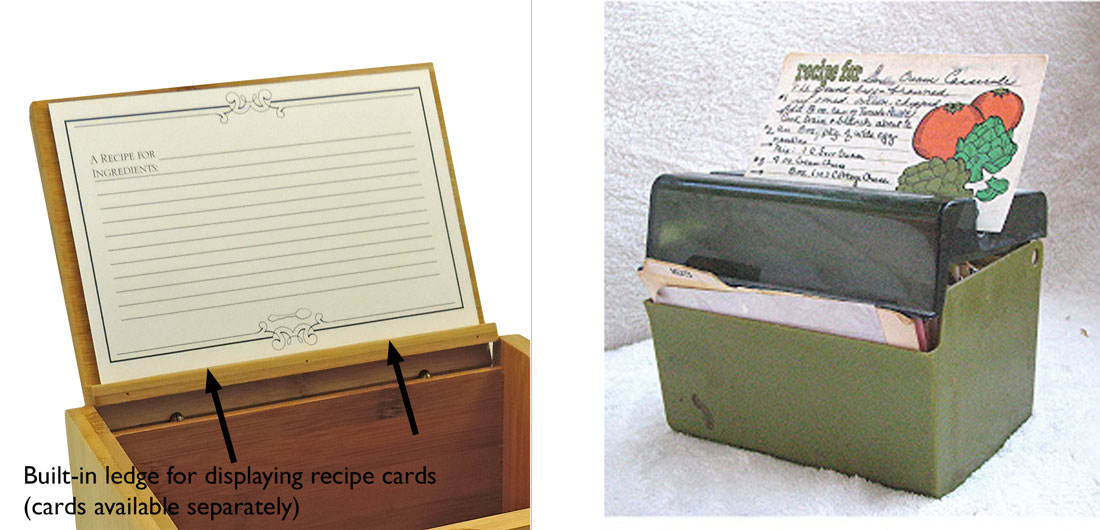
Both work well. We prefer the ledge under the lid just because it gives us the entire top of the lid to engrave the person's name and print a design.
6. How do you want to personalize the lid?
We can engrave any words you like on our wood recipe boxes. It's entirely up to you, but they tend to break down in the following groups:
- Family Name (The Jones Family Recipes): Perfect for the family that cooks, or if the main cook tends to put family first. About 45% of our recipe boxes have some version of this.
- Individual Name (Sarah Jones' Recipes): Some cooks are just more independent, and that's perfectly fine! About 25% of the recipe boxes we ship out go this route.
- Wedding Recipe Boxes (Jones Family Est. 2022, Sarah and Jacob Jones Married 2022): At least 15% of our boxes are for weddings, which I think is a delightful gift.
- Individual Name with Embellishment (Sarah's Awesome Recipes, Chef Jones): Give the pros their dues.
- Inside Jokes, Pet Names, Encouragement (Disasters Waiting To Happen, Delicious Thing Who Makes Delicious Things, Love Cooks Here): You can put anything you want, so make it really, really personal if you like. We won't judge! :)
4. How Many Recipe Cards Will Fit in a Recipe Box?
Your recipe box capacity is limited by the interior depth of your recipe box. We've put together a quick calculator to help you understand how much space your recipe box has and how many recipe cards will fit in it:

If you have more than 300 recipe cards, you really should consider a second recipe box. Cramming them all into one space will make it harder to flip through your recipes without taking them out of the box entirely. Leave yourself some wiggle room for fuss-free filing. Personally, we keep our main recipe box handy on the countertop for daily use, and a secondary recipe box is stashed in a cupboard for special recipes that rarely get used.
5. Recipe Box Materials
Tin
The traditional means of organizing your cards is to put them in a recipe box. My own mom's recipe box was a tin box with rust around the edges. You’ll still see a few tin recipe boxes on the market, and even we used to carry them, but their tendency to rust was a nuisance and they always had a flimsy feel to them.
Paper
About 25 years ago, paperboard/cardboard recipe boxes came into vogue. These often have decorative prints along their exteriors to make them really stand out. They are certainly pleasing to the eye and as far as differing designs go, the options available online are endless—there are styles for everyone! Be wary that these paper-based recipe boxes aren’t super resistant to moisture and staining. Over time, those grease stains and cake batter remnants might begin to take their toll on the integrity of your box. So, if you want a recipe box for a nice 3-6 years before you update to a different design or product material, these are a great solution.
Synthetic Leather
Think of your recipe box in the likeness of a time capsule—it’s more important to preserve what’s on the inside (your family recipes) than the outside. Yet, that preservation begins on the outside of the recipe box with a material that will protect your great-aunt Bertha’s top secret potato salad recipe from all the chaos of the kitchen. Take it from us, it’s best to invest in something a little more enduring. Faux leather style recipe boxes are a great place to start! Below are some examples of this style, which offer more splash resistance while also adding some color to the kitchen:
Recipe boxes, no matter the material, are often fairly easy to customize. I’m partial to this next example because it's got my own wedding photo in it! Was I really ever that young? (-Ted)
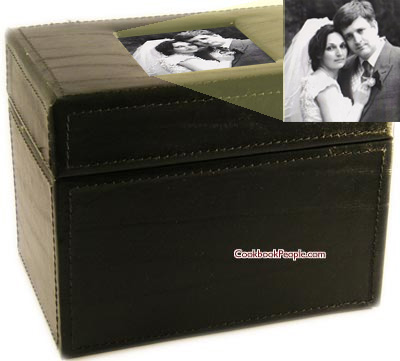
Wood Recipe Boxes
If you’re really set on having a recipe box that is not only customized to your liking but also one of a kind material-wise, then wood is the way to go! Of course, every tree is different. The variations in color, grain, and texture naturally occur among the types of wood boxes we offer, so your hand-crafted order is surely unique. Currents trends even lean more toward wood boxes--they look great in modern kitchens and yet still hold onto a bit of that old-fashioned feel. Traditional hard wood recipe boxes can be made of cherry wood, walnut, oak, cedar or poplar. The best-selling boxes on our own site are bamboo. We offer laser engraving on the lids of the boxes to commemorate and celebrate any occasion you might need--weddings, birthdays, and or just a design to recognize the family cook are some our most frequent requests.
Need another reason to opt for wood over tin, paper, or pleather? Wood is durable and therefore reliable! No rust, no deterioration, and therefore no need to worry about your recipe cards. Not all wood recipe boxes are one in the same either! Read on to meet the types of wood we’re working with at Cookbook People.
Bamboo
We introduced bamboo recipe boxes some number of years ago and they have really taken over the market! With bamboo you get a bright, beautiful hard “wood” that matches most modern kitchens. You might be wondering why we put quotations around the word wood—it’s because bamboo actually isn’t wood at all! Believe it or not, bamboo is a species of grass, but because of its tightly packed molecular structure, it’s more durable than most hardwoods.
Why are 80% of the recipe boxes we sell bamboo?
- They cost less. A bamboo shoot needs only about 7 years to grow before it's ready to be harvested—it’s even been given the title of the world’s fastest growing plant! Typical hardwood trees take 50+ years to grow before they are ready for harvesting. Because our inventory costs are much, much lower for bamboo than they are for our other types of wood, we can pass those low prices on to our customers.
- They are more environmentally sustainable. Because bamboo grows so quickly, it takes a smaller footprint to grow them. Before they become boxes, like any other plant bamboo engages in photosynthesis by absorbing carbon dioxide from the air and giving back oxygen in return. Bamboo, however, goes the extra mile by taking in 4 times more CO2 than other plants and therefore releasing 4 times more oxygen. Even after they become harvested material, every bamboo recipe box that isn't thrown in the trash is sequestering carbon.
- They are just as hard if not harder than most hardwoods. Like we said above!
Acacia
Say hello to the latest addition to our latest addition—Acacia recipe boxes! Popular for its marbled grain pattern, Acacia has made waves as one of the trendiest wood choices for interior design aesthetics in the past year or so. But the heightened demand for acacia wood isn’t just because of its burnt sienna glow and “curly” grain. Acacia is incredibly durable and also naturally water resistant, making it a popular wood choice for hardwood flooring—and as a recipe box! In terms of durability, Acacia is actually stronger than oak, hickory, and even bamboo. Be one of the firsts to get your hands on an acacia recipe box by clicking here!
Fun fact about acacia—when pressed, acacia wood produces an essential oil that is light yellow in color with a honey-like fragrance alongside other floral notes.
Cherry
Ah, classic cherry! This is our favorite recipe box if budget is no option, and you are proud to buy 100% American-made boxes. Cherry wood accepts a very deep laser engraving, has a lighter colored wood, but still looks regal. Our own recipe box at home is cherry hardwood. Cherry is one of the most sought-after lumber sources for its striking color which only gets better with time and ages like fine wine into a dark red-brown patina. Cherry is so tried and true that people depend on it for almost all of their woodworking needs—furniture, cabinetry, flooring, etc. It’s one of the top-rated wood sources for durability too based on its resistance to warping and decay.
Fun fact about cherry wood—the trees from which the lumber is sourced usually range between 50 to 100 ft tall! Check out our cherry recipe boxes here.
Walnut
Walnut is a charming, dark wood with a burnt-umber hue that really stands out in the kitchen. Like cherry wood, walnut is also a product of the USA. If you’re looking into a box made of walnut, but perhaps might like your piece to be engraved, please keep in mind that your engraving of choice won’t appear as starkly on walnut as it would on a light-colored wood, like bamboo or poplar. Walnut is already dark in color, therefore the contrast between the engraving and the untouched wood isn’t as apparent. But for many the subtlety of the engraving is the point. You know you're a great cook--why broadcast it? As for the bright side of dark wood: it has the advantage of hiding stains and blemishes, so walnut is a great choice if you want it to look new 10 years from now. Here is a nice collection of walnut recipe boxes.
Fun fact about walnuts—have you ever noticed how the inside of a shelled walnut looks a bit like a brain? The Greeks called walnuts “karyon,” meaning “head” for that very reason
Oak
Since so many kitchens feature oak cabinetry and tables, it's a natural fit for someone to want a matching recipe box. Oak recipe boxes are built from the strongest wood, so they are naturally the most durable and hardest to scuff. We used to have problems engraving on them because of their hardness, but since we upgraded our technology we no longer have that problem. You'll get a beautiful dark engraving on a nice bright oak box and you'll love it for years! And boy do we mean years--a good oak recipe box is an instant heirloom that will get passed down generations.
Cedar (Discontinued)
We personally love the way cedar recipe boxes can look a thousand different ways depending on the streaks in the wood grain. Each one is different than the rest! Some cedar samples have more amber undertones whereas others are more dominated by a yellow or slightly orange tinge . Cedar is very aromatic too—a bit smokey but still sweet. Despite all the perks of cedar, unfortunately, it doesn't engrave very well so we no longer offer cedar boxes. Due to the fact that cedar naturally tends to have lots of knots, we opted to discontinue these boxes because we just couldn't get consistent results. It’s our first priority to provide you with quality products, and cedar was just too finicky to work with. Even though we’ve said our farewells to cedar, we’re leaving it up here in memory of our favorite box (when they came out well) and our most hated recipe box (when they didn’t.)
Here's a video we made before we discontinued them. Saved for posterity!
6. Wedding Recipe Box: Make it Memorable
Recipe boxes are traditionally a fantastic wedding gift. Here's a video from one happy bride who received it at her bridal shower:
It's certainly a wonderful standalone gift, but you can also do more! Turn your wedding into a truly interactive experience for everyone who attends!
Include a recipe card with each wedding invitation you send out. Also include in the invitation a small card (something business card sized will do) that says:
The Bride and Groom would like to invite you to give you the option to contribute a favorite recipe toward their wedding recipe box. Please fill out the recipe on the enclosed card and it will be included in the box. Be sure to sign it so they will know who to thank.
Alternatively, you can make recipe card sharing an activity to do at the bridal shower. It's a great way to start a new marriage with delightful collection.
Once you have received all the recipes, you can compile a wedding cookbooks using Matilda's Fantastic Cookbook Software, and print them out for a few dollars each. This makes an excellent favor for the wedding. This will leave the guests with a thoughtful gift that will truly commemorate the event.
7. Make Your Own Recipe Box
There are several online videos about making your own wood recipe box, but many of them are pretty involved and require a variety of special tools. I really liked this video because it really only requires a table saw and some glue. I really like how it looks when finished as well.
I wasn't sure about his dimensions when I was making my own, so I whipped together a quick little template for cutting it. I thought I'd attach it here in case anybody wanted to use it too.
8. About Recipe Cards
It's hard to discuss everything to do with recipe boxes while completely overlooking recipe cards. However, this page is already getting quite long, so if you are interested in learning more about recipe cards or just want to print out some free recipe cards, go to our Everything You Need to Know about Recipe Cards page.
Conclusion
Erin and I have been obsessed with recipe boxes and recipe cards and everything recipe organizer-related for more than 20 years. We started off this business by writing our own software to make a family cookbook, and our passion has grown from there. I hope you find the recipe box that suits you!
Here's a summary of the sections just in case you missed something:


